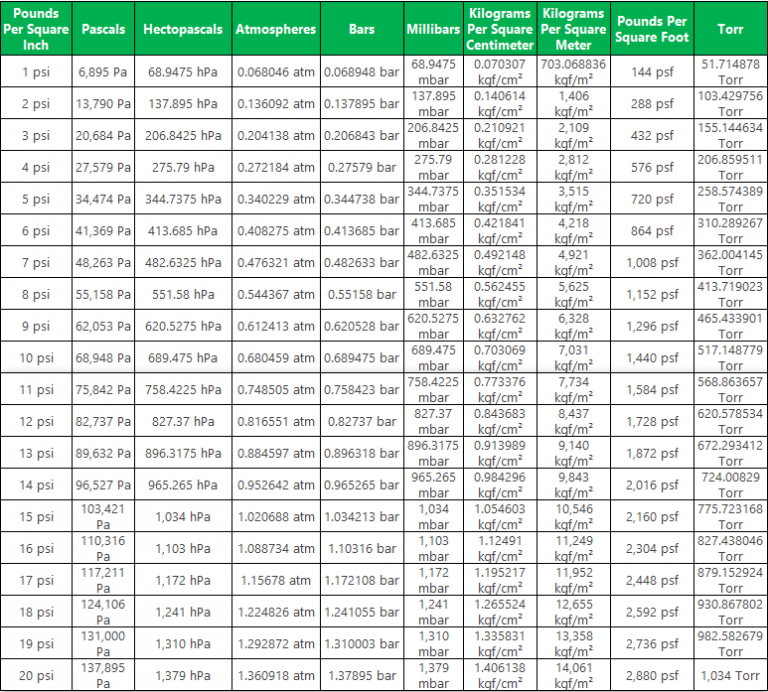

200 bar being a full standard scuba tank, and depth increments of 10 metre of seawater being equivalent to 1 bar of pressure. In scuba diving, bar is also the most widely used unit to express pressure, e.g. As a result, decibars are commonly used in oceanography. In sea water with respect to the gravity variation, the latitude and the geopotential anomaly the pressure can be converted into metres' depth according to an empirical formula (UNESCO Tech. Specifically, an increase of 1 decibar occurs for every 1.019716 m increase in depth. In fresh water, there is an approximate numerical equivalence between the change in pressure in decibars and the change in depth from the water surface in metres. In contrast, Americans are familiar with the use of the millibar in US reports of hurricanes and other cyclonic storms. For example, the weather office of Environment Canada uses kilopascals and hectopascals on their weather maps. After the advent of SI units, some meteorologists began using hectopascals (symbol hPa) which are numerically equivalent to millibars for the same reason, the hectopascal is now the standard unit used to express barometric pressures in aviation in most countries. Despite the millibar not being an SI unit, meteorologists and weather reporters worldwide have long measured air pressure in millibars as the values are convenient. Usage Map showing atmospheric pressure in mbar or hPa A tire-pressure gauge displaying bar (outside) and pounds per square inch (inside)Ītmospheric air pressure where standard atmospheric pressure is defined as 1013.25 mbar, 101.325 kPa, 1.01325 bar, which is about 14.7 pounds per square inch. Between 17, the word bar was used for a unit of weight in an early version of the metric system. The unit's official symbol is bar the earlier symbol b is now deprecated and conflicts with the use of b denoting the unit barn, but it is still encountered, especially as mb (rather than the proper mbar) to denote the millibar. The word bar has its origin in the Ancient Greek word βάρος ( baros), meaning weight. 1 millibar = 1 hectopascal (1 hPa = 100 Pa).1 millibar ( mbar) = 1 one-thousandth bar, or 1 ×10 −3 bar.

1019.716 centimetres of water (cmH 2O) (1 bar approximately corresponds to the gauge pressure of water (not absolute) at a depth of 10 meters).The bar is defined using the SI derived unit, pascal: 1 bar ≡ 100,000 Pa ≡ 100,000 N/m 2. Units derived from the bar include the megabar (symbol: Mbar), kilobar (symbol: kbar), decibar (symbol: dbar), centibar (symbol: cbar), and millibar (symbol: mbar). The International Astronomical Union (IAU) also lists it under "Non-SI units and symbols whose continued use is deprecated". The US National Institute of Standards and Technology (NIST) deprecates its use except for "limited use in meteorology" and lists it as one of several units that "must not be introduced in fields where they are not presently used". The bar has been legally recognised in countries of the European Union since 2004. The International System of Units, despite previously mentioning the bar, now omits any mention of it. The bar and the millibar were introduced by the Norwegian meteorologist Vilhelm Bjerknes, who was a founder of the modern practice of weather forecasting, with the bar defined as one mega dyne per square centimeter. By the barometric formula, 1 bar is roughly the atmospheric pressure on Earth at an altitude of 111 metres at 15 ☌. A pressure of 1 bar is slightly less than the current average atmospheric pressure on Earth at sea level (approximately 1.013 bar). The bar is a metric unit of pressure, but not part of the International System of Units (SI) it is defined as 100,000 Pa (100 kPa). Please use the tool below to link back to this page or cite/reference us in anything you use the information for.A pressure of 700 bar flattened this length of aluminium tubing, which had a wall thickness of 5 millimetres (0.20 in). The best unit of measurement I have found for 10 bar is megapascals and the amount is 1 mgpa. Smaller numbers are more easily understood and can make it easier for you to understand the measurement. To determine which unit is best, I decided to define that as being the unit of measurement which is as low as possible, without going below 1. I've also calculated what the best unit of measurement is for 10 bar. Especially when dealing with really large numbers. Sometimes when you work with conversions from one unit to another, the numbers can get a little confusing. Bars to Pounds per square inch Conversion Tableīelow is a sample conversion table for bar to psi: Bars (bar)

So, the answer to the question "what is 10 bars in pounds per square inch?" is 145.03768078947 psi.


 0 kommentar(er)
0 kommentar(er)
